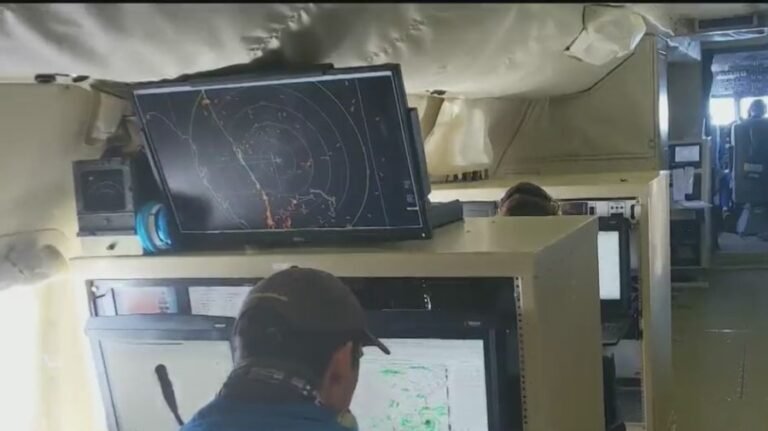LAKELAND, Fla. (WFLA) – When a hurricane threatens the coast, most individuals board up, pack up, and head inland, however for a small however mighty crew based mostly in Lakeland, evacuation isn’t a part of the plan as a result of their job is to fly straight into the attention of the storm.
They’re NOAA’s Hurricane Hunters, a courageous crew of pilots, scientists, engineers, and flight administrators who threat their lives to assemble the info that helps meteorologists predict the place hurricanes will go and the way highly effective they’ll be after they arrive.
“We simply hit a pocket of lightning, and the entire inside of the plane lit up,” stated NOAA pilot Andrew Reves, describing one in all many intense flights. “You may hear the radios pop.”
Flying right into a hurricane takes a whole crew. It’s tightly coordinated and scientifically important. Every flight delivers real-time knowledge to the Nationwide Hurricane Middle in Miami — knowledge that satellites alone can’t present.
“Plenty of occasions, individuals ask if we’re scared once we do that,” stated Captain Nate Kahn, Commanding Officer at NOAA’s Plane Operations Middle. “Completely. However within the second, you are so targeted, so educated, you are not afraid.”
Utilizing two 50-year-old WP-3D Orion turboprop planes nicknamed Kermit and Miss Piggy, the Hurricane Hunters slice by way of intense rain bands. Regardless of their age, the plane haven’t had main structural upgrades — they’re designed to journey the storm, not combat it.
“We enable the storm to push us up and push us down,” Kahn defined. “If we tried to keep up a set altitude, the storm would break the airplane.”
These planes typically expertise fast vertical drops — typically 1,500 toes or extra — in mere seconds, making every flight really feel extra like a rollercoaster than a routine operation. Nevertheless it’s what’s inside that makes the distinction: an array of sensors and devices that gather detailed measurements of wind velocity, barometric stress, temperature, and humidity.
“It’s type of like taking a CAT scan of the storm,” stated aerospace engineer Nick Underwood. “All that knowledge will get pushed collectively to provide us a transparent image of how the storm is creating.”
One of the crucial essential instruments is the dropsonde — a small system launched at particular factors all through the storm that transmits knowledge because it falls. When mixed with radar and different devices, these instruments present the 3D mannequin forecasters depend on.
“We’re always speaking with the bottom and ensuring we’re accumulating the info that issues,” flight director Jon Zawislak stated. “That each one goes into the fashions.”
Whereas new know-how is starting to play a task — like autonomous drones that may fly inside 100 toes of the ocean’s floor — it’s nonetheless the Hurricane Hunters who present the highest-quality, in-storm knowledge.
“We’re utilizing uncrewed techniques to gather knowledge we could not get every other approach,” stated Capt. Invoice Mowitt, Director of NOAA’s Uncrewed Operations Middle. “It’s already displaying us methods we will enhance our fashions.”
For a lot of of those scientists, the mission is private. Some name Florida residence — that means they typically fly into storms threatening their very own neighborhoods.
“We had been the crew on the ultimate mission earlier than Hurricane Milton made landfall,” Zawislak stated. “We might see the results on Tampa Bay and St. Pete. We had been flying proper over it.”
And as hurricane season approaches, these women and men have one message for the individuals on the bottom:
“Be ready. That’s what makes all of this price it.”
From the guts of the storm to our native forecast, the info collected by the Hurricane Hunters is essential for holding communities secure.
WFLA’s “Surviving the Storm” Hurricane particular is airing on Might 31 at 7 p.m. You may watch it at 7 p.m. on air on WFLA Information Channel 8 or by way of the WFLA CTV app.

